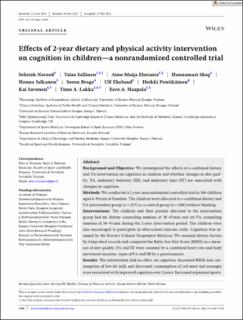| dc.contributor.author | Naveed, Sehrish | |
| dc.contributor.author | Sallinen, Taisa | |
| dc.contributor.author | Eloranta, Aino-Maija | |
| dc.contributor.author | Skog, Hannamari | |
| dc.contributor.author | Jalkanen, Henna | |
| dc.contributor.author | Brage, Søren Karl | |
| dc.contributor.author | Ekelund, Ulf | |
| dc.contributor.author | Pentikäinen, Heikki | |
| dc.contributor.author | Savonen, Kai | |
| dc.contributor.author | Lakka, Timo A. | |
| dc.contributor.author | Haapala, Eero A. | |
| dc.date.accessioned | 2024-02-09T09:29:59Z | |
| dc.date.available | 2024-02-09T09:29:59Z | |
| dc.date.created | 2023-09-13T10:10:31Z | |
| dc.date.issued | 2023 | |
| dc.identifier.citation | Scandinavian Journal of Medicine & Science in Sports. 2023, 33(11), Side 2340-2350. | en_US |
| dc.identifier.issn | 0905-7188 | |
| dc.identifier.uri | https://hdl.handle.net/11250/3116545 | |
| dc.description | This is an open access article under the terms of the Creative Commons Attribution License, which permits use, distribution and reproduction in any medium, provided the original work is properly cited. | en_US |
| dc.description.abstract | Background and Objective: We investigated the effects of a combined dietary and PA intervention on cognition in children and whether changes in diet quality, PA, sedentary behavior (SB), and sedentary time (ST) are associated with changes in cognition.
Methods: We conducted a 2-year nonrandomized controlled trial in 504 children aged 6–9 years at baseline. The children were allocated to a combined dietary and PA intervention group (n = 237) or a control group (n = 160) without blinding.
Interventions: The children and their parents allocated to the intervention group had six dietary counseling sessions of 30–45 min and six PA counseling sessions of 30–45 min during the 2-year intervention period. The children were also encouraged to participate in after-school exercise clubs. Cognition was assessed by the Raven's Colored Progressive Matrices. We assessed dietary factors by 4 days food records and computed the Baltic Sea Diet Score (BSDS) as a measure of diet quality. PA and ST were assessed by a combined heart rate and body movement monitor, types of PA and SB by a questionnaire.
Results: The intervention had no effect on cognition. Increased BSDS and consumption of low-fat milk and decreased consumption of red meat and sausages were associated with improved cognition over 2 years. Increased organized sports, ST, and reading were positively, while unsupervised PA, computer use, and writing were negatively associated with cognition.
Conclusion: Combined dietary and PA intervention had no effect on cognition. Improved diet quality and increased organized sports and reading were associated with improved cognition. | en_US |
| dc.language.iso | eng | en_US |
| dc.subject | brain | en_US |
| dc.subject | exercise | en_US |
| dc.subject | lifestyle | en_US |
| dc.subject | nutrition | en_US |
| dc.subject | pediatrics | en_US |
| dc.title | Effects of 2-year dietary and physical activity intervention on cognition in children: A nonrandomized controlled trial | en_US |
| dc.type | Peer reviewed | en_US |
| dc.type | Journal article | en_US |
| dc.description.version | publishedVersion | en_US |
| dc.rights.holder | © 2023 The Authors | en_US |
| dc.source.pagenumber | 2340-2350 | en_US |
| dc.source.volume | 33 | en_US |
| dc.source.journal | Scandinavian Journal of Medicine & Science in Sports | en_US |
| dc.source.issue | 11 | en_US |
| dc.identifier.doi | 10.1111/sms.14464 | |
| dc.identifier.cristin | 2174585 | |
| dc.description.localcode | Institutt for idrettsmedisinske fag / Department of Sports Medicine | en_US |
| cristin.ispublished | true | |
| cristin.fulltext | original | |
| cristin.qualitycode | 1 | |
